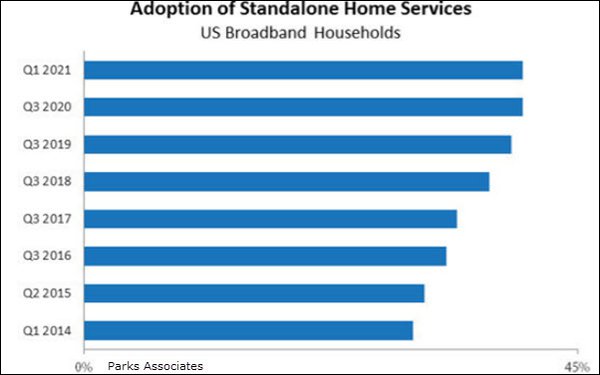
Virtual MVPDs’ share of total U.S.
pay-TV subscriptions reached 16% last year, as household broadband services adoption grew and more than 7 million households dropped their traditional pay-TV services in 2020 alone, according to Parks
Associates estimates in a new report on the shifting broadband landscape.
While some analysts continue to question the long-term financial viability of vMVPDs, Parks reports that the
channel collectively added about 3 million subscriptions in 2020, making it the only segment of the U.S. pay-TV space to experience growth during the COVID pandemic.
Traditional pay-TV
services (defined as those delivered over an operator-controlled network to an operator-controlled device) lost an estimated 18 million U.S. subscriptions (as opposed to households) between 2014 and
2020, and 10 million last year, the researcher estimates.
Meanwhile, the broadband market has accelerated, with 40% of U.S. broadband households now receiving a standalone service
— facilitating the growth of national net-based TV services.
advertisement
advertisement
Online pay-TV service from virtual MVPDs — players that target the general population instead of offering services to a
specific geographic footprint — “have grown to represent an increasingly large percentage of the pay-TV market," says Kristen Hanich, senior analyst at Parks Associates.
By 2024,
the traditional pay-TV subscriber base will decline to just 53 million U.S. households, while vMVPDs will increase to more than 23 million, the analysis estimates.
Another result of the
decline in traditional pay-TV households: Internet service providers and others currently operating in that space are pushing to establish their own alternative services.
U.S. cablecos
have had some success in encouraging new bundling by launching Wi-Fi-first MVNO (mobile virtual network operator) services, primarily running on Verizon's network, notes Parks. (Like landline
telephone resellers, MVNOs sell service under their own brands, but use the facilities of mainstream carriers.)
In a Q1 2021 Parks survey, 4% of U.S. broadband households reported
subscribing to Comcast Xfinity Mobile, Spectrum Mobile, or Altice Mobile, making them some of the largest players in the MVNO space.
U.S. ISPs collectively had more than 110 million
residential and small-business internet subscriptions as of the first quarter.
"The standalone broadband market will continue to grow, increasing pressure on these service providers to
find the next combination of services that best leverages this massive subscriber base,” says Hanich.